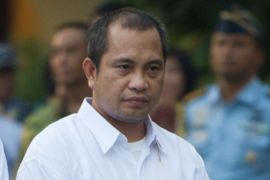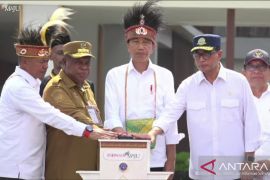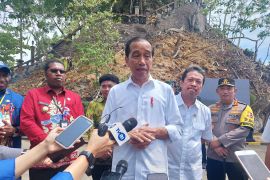It means that this year, each village alone will get around Rp280.3 million."Jakarta (ANTARA News) - The government of President Joko Widodo (Jokowi) and Vice President M. Jusuf Kalla is undeniably serious about developing rural areas across regions in Indonesia.
In a bid to develop more than 74 thousand villages across the country, the government will allocate Rp20.7 trillion in funds this year to offer a direct boost to rural economic growth, including support to small businesses in the villages.
According to village Law No. 6 of 2014, every village will receive 10 percent of the total funds transferred by the central government from the state budget, plus 10 percent from the regional budget.
"It means that this year, each village alone will get around Rp280.3 million," according to Rural, Disadvantaged Regions and Transmigration Minister Marwan Jafar as quoted by Ayo ke Desa (Lets Go to Village) magazine, published by the Ministrys Directorate General of Rural Area Development.
However, such a large amount of money cannot be divided arbitrarily, as it belongs to all the people of Indonesia and has to be used properly without any misappropriation.
Therefore, the entire amount will not be given immediately but gradually over a period of five years with certain provisions.
"The disbursement process will be conducted in three phases: the first phase of disbursement was carried out in mid-April, which is 40 percent of the funds, or Rp8.3 trillion; second phase of the same amount will be disbursed in August; and the third phase, which amounts to 20 percent of the funds, or Rp4.1 trillion, will be given in October 2015," Marwan remarked.
According to Marwan, the disbursement procedure of the village development funds will not be complicated.
He affirmed that the central government, through the Ministry of Finance, will channel the funds from the state budget to the regional budget in the regions and will then be distributed to the villages.
However, only those villages that have prepared their Mid-term Village Development Plan (RPJMDes) and Village Administration Plan of Action (RKPDes) are eligible to receive the funds.
In addition, the distribution of funds is also based on other considerations such as the population, area of the village, poverty level, and the level of difficulty of geographical access.
Based on these considerations, the amount of funds to be received by each village will be different, but its value will be increased in 2016 to reach Rp1.4 billion.
"Therefore, we continue to encourage the district/city governments to immediately realize these regulations, so that the funds can be immediately transferred," the minister noted.
Once the funds are disbursed, the potential for leakage and diversion is not likely to occur.
Hence, the government is involving the Supreme Audit Board (BPK) to audit the budget and the Indonesian Institute of Accountants to issue a reporting module that will be distributed to the villages.
Marwan pointed out that the rural development funds will be used for priority programs under Village Minister Regulation No. 5 of 2015 on rural development and the empowerment of rural communities.
"Other needs can also be financed with the funds as long as the priority programs have been met," the rural, disadvantaged regions and transmigration minister affirmed.
He noted that the funds will also be used to develop basic infrastructure in the rural areas such as roads, facilities for worship, and other forms of rural infrastructure.
Moreover, the funds can be used for building productive facilities and infrastructure such as to establish the Village-owned Enterprises (BUMDes) that will represent the village administration in realizing the national development programs at the village level.
The types of BUMDes can also vary such as the management of waterways, fruit tree plantations, agriculture, and others.
"The use of the rural development funds depends on the needs of the village and the ability of each village to manage the funds," Marwan remarked.
In the meantime, Rural, Disadvantaged Regions and Transmigration Ministrys Director General for Rural Area Development Johozua Max Yoltuwu explained that the BUMDes will be developed in several villages across the country.
"For this year alone, the ministry will use the funds to establish at least 40 thousand BUMDes," Max said.
He noted that besides being used for physical development, the funds can be utilized to empower the rural communities through training programs to improve their ability, including for the economic business group.
Max explained that the poverty in disadvantaged villages can be addressed with the support of the funds to create self-supporting villages and to raise the quality of living of the rural communities.
"Self-supporting villages are expected to meet their own aspects of social needs, basic infrastructure, basic facilities, and public services," he remarked.
He pointed out that of all 74,094 villages across the country, 39,086 villages fall under the backward category and 17,268 belong to the very backward category.
"Backward villages are the villages that have not been able to meet the Minimum Service Standard (SPM) on the aspects of social needs, facilities, public services, and governance," Max explained.
According to Coordinating Minister for Culture and Human Development Puan Maharani, rural development will be carried out by prioritizing the villages based on the categories of backward, remote, and frontier that share their border with other country.
"Under the rural development program, the government will prioritize the backward, remote, and frontier villages, which are known as villages with 3T (Tertinggal, Terpencil, Terdepan) category," Puan noted here recently.
She added that the development of villages in the 3T category is on top priority of the Jokowi governments development program.
(T.O001/INE/KR-BSR/A014)
Reporter: Otniel Tamindael
Editor: Priyambodo RH
Copyright © ANTARA 2015












